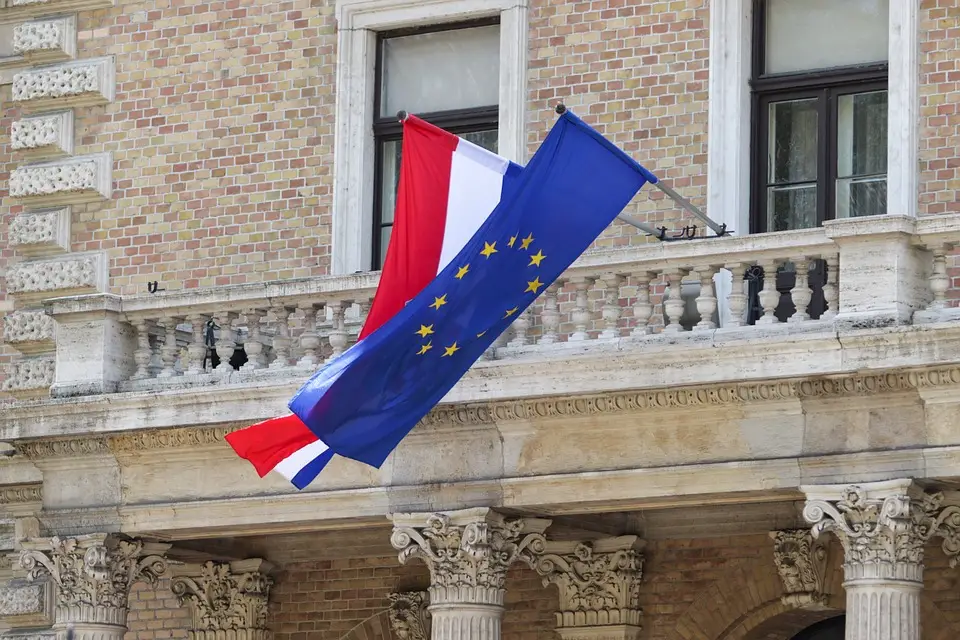Two years ago, the devastating Banovina earthquake struck the Sisak-Moslavina area of Central Croatia. How well has the state done in tackling the consequences? Horrifically poorly, according to many…
We’re now just past the second anniversary of the awful earthquake, known as the Petrinja earthquake, struck the aforementioned part of the country. Not only is this region criminally overlooked by the powers that be at the best of times, its position on the list of priorities has well and truly shown itself after this natural disaster struck at the very end of an already terrible year (2020).
Not much has altered for those who had life as they knew it crumble in the space of just several minutes back on the 29th of December, 2020. Dissatisfaction reigns strong among the earthquake victims, but also among the participants in the reconstruction process, which Prime Minister Andrej Plenkovic himself referred to as being “unbelievably slow”. This comment among other things which have been building up over the past two years started speculations about the potential dismissal of the Minister Ivan Paladina, who has claimed that the comment made by the Prime Minister doesn’t apply and wasn’t in reference to him.
The residents of the houses which are still sitting in ruin, in some cases as if the earthquake happened yesterday, are dissatisfied because most of them are still waiting in containers to return to their should-have-been newly renovated homes, but the completion of the renovation process of these Banovina houses isn’t yet in sight. Rather unsurprisingly for anyone who knows even the faintest thing about Croatia’s masochistic love of red tape, there are still many bureaucratic windmills turning.
Local authorities in the affected areas are also dissatisfied because the desired structural renovation of the houses and the construction of replacement houses and residential buildings didn’t achieve the expected momentum, despite the amendments to the Law on Reconstruction which were put into force back in October 2021, in which great hopes were placed on precisely that.
As touched on above, PM Plenkovic’s recent statement that the reconstruction of the entire Banovina area “is going unbelievably slowly” fuelled speculations about the resignation of Minister Paladina, who took up his post in March, after the resignation of former Minister Darko Horvat, who ended up in jail for some time (enter your shocked Pikachu meme here).
However, Paladina claimed that Plenkovic’s statement about the “unbelievably slow recovery” wasn’t in reference to him at all and was misinterpreted. The statement refers, he clarified, to the fact that the structural renovation of houses and buildings and the construction of replacement houses are not progressing at a sufficiently quick pace, which he has been saying for months on end now.
“Only when we start doing 100 houses a month can we actually be satisfied. I’ve been saying this for more than three or four months now. The Prime Minister’s statement refers to that part of the renovation that must be accelerated,” he said.
Croatia’s accession to the Eurozone is now just days away. Here’s how that journey began five years ago
Croatia is set to become the 20th member state of the Eurozone, send the kuna to the history books and adopt the bloc’s single currency as its official currency in just days. This moment has been being prepared for intensively for around a year now, but the real wheels were set in motion half a decade ago.
Back at the end of October 2017, a large conference was held where the Strategy proposal for the introduction of the euro as the official currency in Croatia was presented. This marked the beginning of a broad public debate on the introduction of the euro, when the government’s goal was proclaimed that Croatia would take the first step towards the introduction of the euro, entry into the European Exchange Rate Mechanism II (ERM II), in 2020, when it was due to hold the rotating EU presidency.
The strategy was drawn up by experts from the Croatian National Bank (CNB) and the government, emphasising that the benefits which come from the introduction of the euro are permanent and significant, while the costs are mostly low and one-off. The strategy was finally adopted at the government session on May the 10th, 2018, when the then Economy Minister Martina Dalic, stated that a period of five to seven years would be a realistic period in which the euro could be introduced as the country’s currency.
Then, back in early July 2019, Croatia sent a letter of intent to join ERM II, which was signed on behalf of the nation by Finance Minister Zdravko Maric and CNB Governor Boris Vujcic. That letter was accompanied by an Action Plan, with which Croatia committed itself to the implementation of nineteen measures and reforms spanning six areas, including further strengthening the supervision of the banking system by establishing close cooperation between the CNB and the European Central Bank (ECB), strengthening the framework for the implementation of macroprudential policy by introducing explicit mandate for measures aimed at borrowers, strengthening the framework for preventing money laundering, improving the system of collecting, processing and publishing statistical data, improving management in the public sector and reducing the administrative and financial burdens on the economy.
Croatia was deemed to have successfully fulfilled the Action Plan for joining ERM II and the banking union on time and in full, Prime Minister Andrej Plenkovic announced at the government session in May 2020.
A couple of months later, in July 2020, entry into the European Exchange Rate Mechanism II (ERM II) took place. On July the 10th, 2020, the ECB and the European Commission announced that Croatia had indeed entered ERM II, and that the CNB had established close cooperation with the ECB. Entry into ERM II followed less than a week after the victory of HDZ and its coalition partners in the then parliamentary elections. ERM II is also called the “waiting room for the euro”, and candidate countries must spend at least two years in it, which meant the possibility that Croatia could introduce the euro as early as January the 1st, 2023. At the same time, the emphasis was placed on fulfilling the so-called criteria from Maastricht, that is, criteria of nominal convergence, which includes exchange rate stability, price stability, interest rate stability, along with two important indicators concerning public finances – budget deficit and public debt.
Croatia’s entry into ERM II wasn’t hindered by the coronavirus pandemic either, although its consequences represented a major challenge for public finances. On November the 11th, 2020, at the session of the National Council for the introduction of the euro, CNB Governor Boris Vujcic presented the National Plan for replacing the Croatian kuna with the euro, a document that described everything that needed to be done, including the activities of stakeholders from both the private and public sectors, in order to create the conditions for Croatia to introduce the euro on the first day of 2023, with consumer protection highlighted as its fundamental principle.
It meant, among other things, that the exchange of the kuna into the euro would be carried out at no cost to individuals, companies or the state, and that it would be done exclusively at a fixed conversion rate. The government adopted the plan on December the 23rd of that year, while on the last day of 2020, it appointed the management committee and the heads and heads of six coordination committees for the implementation of the plan. After a public consultation on the desired national motifs for the Croatian side of the new euro coins, which lasted from July the 1st to the 15th, 2021, the CNB’s Money Commission determined the final proposal on July the 21st, and the proposed motifs were a checkerboard, a geographical map of Croatia, the kuna (a pine marten/mink type of animal), the Glagolitic script and of course – Nikola Tesla.
At the beginning of August 2021, the CNB announced a tender for the design of the national side of euro coins, and on February the 4th this year, the most successful designs were presented to the public, for which the authors received generous cash prizes.
Back in mid-January 2022, a proposal for a law on the euro was presented and submitted for public consultation, and the guidelines for adjusting the domestic economy in the process of replacing the Croatian kuna with the euro were also presented. At that time, among other things, it was announced that from September the 5th of this year, it would be mandatory for all business entities to display their sale prices in both kuna and euros, as one of the mechanisms to protect consumers from unjustified price increases. On May the 13th, the Croatian Parliament adopted the Law on the introduction of the euro as the official currency in Croatia. 117 MPs voted for the law, 13 were against it, and one abstained.
Finally, on June the 1st, 2022, the ECB and the Commission announced that Croatia had succeeded in meeting the convergence criteria, that its legislation was fully aligned with the requirements of the EU Treaty and the Statute of the European System of Central Banks/European Central Bank, and that it was ready to become the 20th member of the Eurozone from January the 1st, 2023.
Looking primarily at the Maastricht criteria, the biggest focus was placed on price stability, i.e. inflation, which began to rise across Europe and the rest of the world due to the consequences of the coronavirus pandemic, and later owing to Russia’s aggression against Ukraine.
Over the last 12 months, Croatia has had an inflation rate of 4.7 percent, which was below the reference value of 4.9 percent. In order to meet this criterion, inflation couldn’t have been allowed to spiral higher than 1.5 percent of the reference value, which is based on the average inflation in the three EU member states with the lowest inflation of all. In the past year, these were Finland, France and Greece, while Malta and Portugal were excluded from the calculation, where inflation deviated considerably from the European average due to much more specific reasons.
With the green light having been obtained from the Commission and the ECB, Croatia’s path to full Eurozone membership was opened up.
In mid-June, the Eurogroup and the Council of the EU recommended that Croatia introduce the euro from January the 1st, 2023, followed by support for Croatian membership from the European Council and the European Parliament, and finally, on July the 12th, the Council for Economic and Financial Affairs of the EU (Ecofin) adopted three legal acts that were necessary for Croatia to become the latest member of the Eurozone, among other things, the decision on the conversion rate of kuna to euro according to the central parity of 1 euro = 7.53450 kuna.
On July the 5th, it was announced that the Deputy Prime Minister and Minister of Finance Zdravko Maric was resigning from his duties, but he still had the opportunity to attend that Ecofin session, which he apostrophised as a kind of “dot on the i” of his entire (and rather long) mandate. The three leading credit rating agencies – Standard&Poor’s, Fitch and Moody’s – responded to Ecofin’s decision by raising their ratings, which also gave Croatia its highest investment rating in its history, provided by all three agencies.
In the entire process of introducing the euro, 19 sessions of the National Council for the introduction of the euro as the official currency in the Republic of Croatia were held, in which, in addition to representatives of the government and the CNB, the representatives of banks, employers and trade unions also sat. On Wednesday, December the 28th, the last session of the Council before Croatia joins the Eurozone was held, and all key actors, from representatives of the CNB and the government, to the heads of Fina and Croatian Post and the largest banks operating in Croatia, reported that all the necessary preliminary work had successfully been done and that all systems are ready for the transition to the new currency.
Governor Boris Vujcic reported, among other things, that so far 400 million euro coins with Croatian national motifs had been minted, a process that began back in July at the Croatian Mint in Sveta Nedelja near Zagreb. The large logistical effort of currency exchange was accompanied by the withdrawal of the current kuna from circulation, which regards about 1.1 billion coins and 500 million banknotes.
The CNB started with the first pre-supply of euro coins and banknotes three months before January the 1st, which included banks, Fina and Croatian Post, while the distribution of packages of euro coins to individuals began on December the 1st. People have so far bought 682 thousand of these packages, individually worth 100 kuna.
Boris Vujcic also reported that all the planned amount of euro banknotes had been acquired, and the supply of business entities, which is carried out by banks, is now nearing its end.
In addition to the legal obligation of double reporting of prices (in kuna and euros), which came into effect on September the 5th, business entities were invited from August the 16th onwards to join the Code of Ethics, the goal of which is to enable a reliable and transparent exchange of the Croatian kuna with the euro. By December the 28th, 1,006 business entities had joined it. In addition, in order to acquaint the general population with all aspects of the introduction of the new currency, the government and the CNB conducted informative and educational campaigns in autumn which spanned all major Croatian cities.
When it comes to the legislative activities related to the introduction of the euro, Finance Minister Marko Primorac reported at a recent session of the Euro Council that 70 national laws were amended to reflect the introduction of the euro, and the harmonisation of Croatian legislation will continue throughout 2023.
Croatia is set to join Schengen on the same day as it introduces the euro as its tender. No country has joined both the Eurozone and the passport-free Schengen zone on the same day before
Along with accession to the Eurozone, which I truly believe I’ve covered enough now, Croatia is also set to enter Schengen, the border-free, passport-free zone which truly encompasses one of the EU’s four primary pillars of function – freedom of movement. The zone is the globe’s largest visa-free zone of all, currently encompassing 27 European nations (28 when Croatia joins), which have officially abolished all forms of border controls at their national borders. Named after a town in Luxembourg where the original agreement was signed by Germany, France, Belgium, Luxembourg and the Netherlands back in 1985, Schengen has attracted controversy during various political crises, especially those which involve migrant crises.
Controversy aside, the Schengen zone allows for the completely free movement of as many as 400 million people, and Croatia joining the zone will aid the tourist sector greatly, as the long lines at the land borders we’ve come to know each summer will be a thing of the past, and Croatia will also be in charge of protecting the EU’s longest external border. It’s worth noting that while land borders with other EU countries will be abolished with immediate effect on the 1st of January next year, the new Schengen rules for Croatian airports won’t come into force until March.
For more on Croatian politics, make sure to check out our dedicated section and keep an eye out for our Week in Politics articles which are published each Friday.










